Dragons in Chinese Visual Art and Sculpture: An Exploration of Symbolism and Craftsmanship

The dragon is one of the most enduring and significant symbols in Chinese culture. In visual art and sculpture, the image of the dragon is both a representation of power and a reflection of ancient beliefs, transcending the boundaries of mere decoration to become a symbol of spiritual, cultural, and imperial authority. Throughout China’s long history, dragons have been used to express and embody key philosophical, political, and social values. This article delves into the role of dragons in Chinese visual art and sculpture, exploring their historical significance, artistic representations, and symbolic meanings.
The Cultural Significance of Dragons in Chinese Art
In Chinese mythology and culture, the dragon is not a mere mythical creature but a profound symbol of nature’s forces and the divine. It is often depicted as a benevolent creature associated with imperial power, prosperity, and good fortune. Unlike the fearsome dragons of Western mythology, which are often seen as destructive and malevolent, the Chinese dragon is revered as a symbol of harmony, strength, and protection. Its image is deeply woven into the fabric of Chinese art, where it conveys both the spiritual and material aspirations of the Chinese people.
The dragon’s significance is embedded in its role as a symbol of cosmic order and protection. It is linked to the emperor, who was often referred to as the “Son of Heaven,” and the dragon was seen as a manifestation of divine authority. Thus, in Chinese visual art, the dragon is not merely a decorative motif; it carries a deep cultural meaning tied to governance, the celestial realm, and the human connection to the divine.
Dragons in Ancient Chinese Visual Art
The representation of dragons in Chinese art dates back to the earliest dynasties, where the dragon was revered for its association with power and sovereignty. During the Shang Dynasty (1600–1046 BCE), some of the earliest depictions of dragons appeared in jade carvings, bronze vessels, and pottery. These early representations were often abstract and stylized, with the dragon depicted as a composite creature featuring elements of serpents, fish, and other animals, emphasizing its connection to the forces of nature.
The development of dragon iconography over time saw a shift towards more intricate and elaborate designs. In the Zhou Dynasty (1046–256 BCE), dragon motifs began to emerge in the decoration of ceremonial bronze vessels. These vessels were often used in ancestral rites and were highly detailed, with dragon patterns symbolizing both divine power and protection. The art of bronze casting allowed for the creation of highly detailed and finely crafted representations of the dragon, enhancing its significance as an emblem of authority and strength.
One of the most important artistic periods in the development of dragon imagery in Chinese art was the Tang Dynasty (618–907 CE). During this time, dragons became a common motif in religious art, particularly in Buddhist and Daoist temples. Sculptures, frescoes, and paintings often depicted dragons as guardians of sacred spaces, further solidifying their role as protectors of both spiritual and earthly realms.
Dragons in Chinese Sculpture
Sculpture played a central role in the depiction of dragons in Chinese art, particularly in monumental works of art. Over the centuries, Chinese sculptors honed their craft, creating stunning representations of dragons in a variety of mediums, including wood, jade, bronze, and stone. These sculptures were often used in public spaces, religious sites, and imperial palaces, where they could serve as both artistic masterpieces and potent symbols of authority and divine power.
The use of dragons in Chinese sculpture is perhaps most evident in the architecture of temples, palaces, and tombs. The Forbidden City in Beijing, for example, is a prime example of imperial architecture where dragons play a central role in its visual design. The palace complex is home to numerous dragon motifs, from the ornate golden dragons decorating the walls and roofs to the carved dragon thrones used by the emperors. The dragon in this context was a symbol of the emperor’s connection to heaven, as well as a mark of imperial status.
Another famous example of dragons in Chinese sculpture is the dragon columns found at ancient temples and tombs. These columns often featured intricate dragon carvings and were believed to have protective qualities. The dragons were carved to ward off evil spirits and bring blessings to the site, ensuring that the sacred space remained protected and auspicious. In some cases, the dragons were shown in dynamic poses, swirling around the column, symbolizing their power and movement.
In addition to monumental sculptures, smaller, portable representations of dragons were also created. These included jade carvings, gold jewelry, and bronze figurines. The use of jade, in particular, was significant because it was believed to have protective qualities. Dragons carved from jade were thought to bring good fortune, health, and longevity to their owners. The intricate craftsmanship and symbolism of jade dragon sculptures highlight the importance of the dragon as both a spiritual and material symbol.
The Aesthetic Evolution of Dragon Imagery in Chinese Art
Over the centuries, dragon imagery in Chinese art evolved significantly, reflecting changes in both artistic style and philosophical thought. In the Song Dynasty (960–1279 CE), for example, there was a greater emphasis on refinement and elegance in art, and this was reflected in the portrayal of dragons. The dragons of this period were often depicted in a more stylized, fluid manner, with graceful curves and delicate details. The dragon became a symbol of refined power, associated with intellectual and cultural pursuits as well as political authority.
During the Ming Dynasty (1368–1644 CE), dragon imagery reached its peak in terms of craftsmanship and grandeur. The dragon became a dominant feature in imperial art, with elaborate depictions appearing in textiles, ceramics, and decorative objects. Ming-era ceramics, in particular, featured dragons prominently, with blue-and-white porcelain often depicting dragons as they swirled around clouds or sea waves. These ceramics were highly prized and were often used as gifts to demonstrate wealth, prestige, and imperial favor.
The Qing Dynasty (1644–1912 CE) continued the tradition of dragon imagery in art, but with a shift towards more complex, multi-dimensional designs. Dragons were often depicted in interaction with other symbols of imperial power, such as phoenixes and tigers. These interactions served to emphasize the emperor’s central role as the divine ruler, as well as the balance of forces in the cosmos.
Dragons in Chinese Ceramics
One of the most iconic forms of dragon art in Chinese culture is the use of dragons in ceramics. Dragon motifs are commonly found on pottery and porcelain from various dynastic periods. From the Tang Dynasty’s colorful glazed pottery to the intricate blue-and-white porcelain of the Ming Dynasty, dragons were a central motif in Chinese ceramics. These dragons were often depicted in dynamic poses, swirling and coiling around clouds, waves, or other natural elements.
The symbolism of dragons in Chinese ceramics is multifaceted. The dragon represents imperial power and protection, and its presence on ceramics served to enhance the status and prestige of the owner. For example, porcelain vases adorned with dragon motifs were often gifts from the emperor to noble families, symbolizing their elevated status and connection to the ruling power.
The craftsmanship involved in creating these ceramic pieces was highly sophisticated. Artists would use a variety of techniques, such as painting, carving, and glazing, to create intricate dragon patterns on the surface of pottery. These works of art were not only functional objects but also highly valued decorative items, reflecting the artistry and technical skill of Chinese artisans.
Dragons in Chinese Textiles
In addition to sculpture and ceramics, dragons also played a prominent role in Chinese textiles. Imperial robes, for example, were often embroidered with dragon designs to denote the wearer’s status. The dragon on a robe was a symbol of the emperor’s divine power and connection to the celestial realm. The robes were often crafted using luxurious materials such as silk and gold thread, and the embroidery techniques used to create the dragon imagery were highly intricate and labor-intensive.
The most famous example of dragon imagery in textiles is the dragon robes worn by Chinese emperors during ceremonial occasions. These robes typically featured a five-clawed dragon, which was exclusive to the emperor, symbolizing his supreme status as the “Son of Heaven.” The dragon on these robes was surrounded by other symbolic elements, such as clouds, waves, and mountains, all of which were linked to imperial symbolism and the forces of nature.
Conclusion: The Enduring Legacy of the Dragon in Chinese Art
The dragon holds a place of honor in Chinese art, serving as both a symbol of imperial power and a representation of the forces of nature and the divine. Through its representation in sculpture, ceramics, textiles, and other forms of visual art, the dragon has transcended time and dynasties, remaining a constant symbol of strength, prosperity, and protection. The intricate craftsmanship and symbolic meaning behind these dragon representations underscore their enduring importance in Chinese culture.
From the earliest jade carvings to the grand sculptures of the Forbidden City, dragons have played a pivotal role in shaping the visual identity of China. Today, the legacy of dragons in Chinese art continues to inspire artists, collectors, and admirers around the world, ensuring that the powerful symbolism of the dragon remains an integral part of Chinese cultural heritage.

